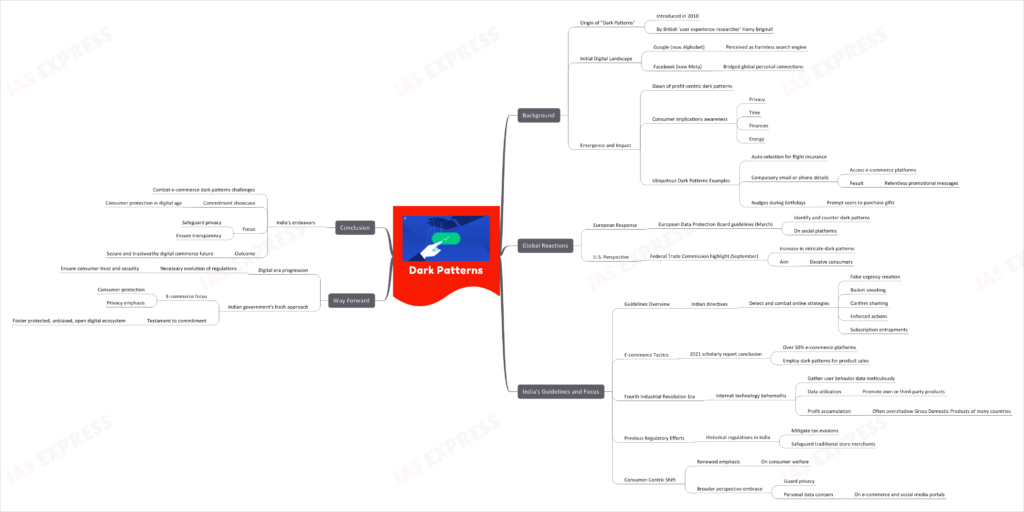Dark Patterns- How is India Regulating E-Commerce Trade Practices?
From Current Affairs Notes for UPSC » Editorials & In-depths » This topic
IAS EXPRESS Vs UPSC Prelims 2024: 85+ questions reflected
India’s proactive move to control e-commerce’s covert trade practices, termed “dark patterns,” is a commendable and timely measure. This initiative, stemming from discussions with sector participants and consumer advocacy groups, culminating in draft guidelines, aims to bring this significant issue to the forefront.

Background
- Origin of “Dark Patterns”: The term “dark patterns” was introduced in 2010 by the British ‘user experience researcher’ Harry Brignull.
- Initial Digital Landscape:
- Google, now known as Alphabet, was perceived as a harmless search engine.
- Facebook, currently recognized as Meta, bridged global personal connections.
- Emergence and Impact:
- The dawn of profit-centric dark patterns was evident.
- Consumers were mostly unaware of the implications concerning their privacy, time, finances, and energy.
- Ubiquitous Dark Patterns Examples:
- Auto-selection of travel insurance during flight bookings.
- Compulsory provision of email or phone details to access e-commerce platforms, leading to relentless promotional messages.
- Nudges prompting users to purchase gifts during birthday acknowledgments.
Global Reactions
- European Response:
- The European Data Protection Board provided guidelines in March to identify and counter dark patterns on social platforms.
- U.S. Perspective:
- The Federal Trade Commission highlighted the increase in intricate dark patterns in September, aiming to deceive consumers.
India’s Guidelines and Focus
- Guidelines Overview:
- The Indian directives present methods to detect and combat online platform strategies like:
- False urgency creation.
- Basket sneaking.
- Confirm shaming.
- Enforced actions.
- Subscription entrapments.
- The Indian directives present methods to detect and combat online platform strategies like:
- E-commerce Tactics:
- A 2021 scholarly report concluded that over half of e-commerce platforms employ dark patterns for product sales.
- Fourth Industrial Revolution Era:
- Internet technology behemoths have meticulously gathered user behavior data.
- Utilization of this data to promote own or third-party products.
- Accumulation of profits that often overshadow the Gross Domestic Products of numerous countries combined.
- Previous Regulatory Efforts:
- Historically, India’s regulations were restricted to:
- Mitigation of tax evasions.
- Safeguarding traditional store merchants.
- Historically, India’s regulations were restricted to:
- Consumer-Centric Shift:
- Renewed emphasis on consumer welfare.
- Embracing a broader perspective to guard privacy concerning personal data on e-commerce and social media portals.
Way Forward
As the digital era progresses, regulations must evolve simultaneously to ensure consumers’ trust and security. The Indian government’s fresh approach to e-commerce, focusing on consumer protection and privacy, is a testament to its commitment towards fostering a protected, unbiased, and open digital ecosystem.
Conclusion
India’s endeavors to combat the challenges posed by e-commerce dark patterns underscore its commitment to consumer protection in the digital age. By focusing on safeguarding privacy and ensuring transparency, India paves the way for a more secure and trustworthy digital commerce future.
Practice Question for Mains
What are dark patterns? How is India regulating such practices? (250 words)
If you like this post, please share your feedback in the comments section below so that we will upload more posts like this.

